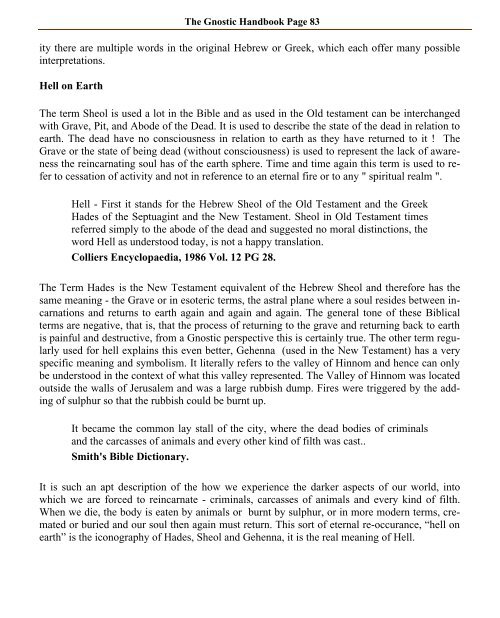gnostic handbook
gnostic handbook
gnostic handbook
You also want an ePaper? Increase the reach of your titles
YUMPU automatically turns print PDFs into web optimized ePapers that Google loves.
The Gnostic Handbook Page 83<br />
ity there are multiple words in the original Hebrew or Greek, which each offer many possible<br />
interpretations.<br />
Hell on Earth<br />
The term Sheol is used a lot in the Bible and as used in the Old testament can be interchanged<br />
with Grave, Pit, and Abode of the Dead. It is used to describe the state of the dead in relation to<br />
earth. The dead have no consciousness in relation to earth as they have returned to it ! The<br />
Grave or the state of being dead (without consciousness) is used to represent the lack of awareness<br />
the reincarnating soul has of the earth sphere. Time and time again this term is used to refer<br />
to cessation of activity and not in reference to an eternal fire or to any " spiritual realm ".<br />
Hell - First it stands for the Hebrew Sheol of the Old Testament and the Greek<br />
Hades of the Septuagint and the New Testament. Sheol in Old Testament times<br />
referred simply to the abode of the dead and suggested no moral distinctions, the<br />
word Hell as understood today, is not a happy translation.<br />
Colliers Encyclopaedia, 1986 Vol. 12 PG 28.<br />
The Term Hades is the New Testament equivalent of the Hebrew Sheol and therefore has the<br />
same meaning - the Grave or in esoteric terms, the astral plane where a soul resides between incarnations<br />
and returns to earth again and again and again. The general tone of these Biblical<br />
terms are negative, that is, that the process of returning to the grave and returning back to earth<br />
is painful and destructive, from a Gnostic perspective this is certainly true. The other term regularly<br />
used for hell explains this even better, Gehenna (used in the New Testament) has a very<br />
specific meaning and symbolism. It literally refers to the valley of Hinnom and hence can only<br />
be understood in the context of what this valley represented. The Valley of Hinnom was located<br />
outside the walls of Jerusalem and was a large rubbish dump. Fires were triggered by the adding<br />
of sulphur so that the rubbish could be burnt up.<br />
It became the common lay stall of the city, where the dead bodies of criminals<br />
and the carcasses of animals and every other kind of filth was cast..<br />
Smith's Bible Dictionary.<br />
It is such an apt description of the how we experience the darker aspects of our world, into<br />
which we are forced to reincarnate - criminals, carcasses of animals and every kind of filth.<br />
When we die, the body is eaten by animals or burnt by sulphur, or in more modern terms, cremated<br />
or buried and our soul then again must return. This sort of eternal re-occurance, “hell on<br />
earth” is the iconography of Hades, Sheol and Gehenna, it is the real meaning of Hell.


